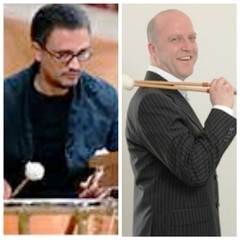|
Back
The Joys of Non-Unity New York
Isaac Stern Auditorium, Carnegie Hall
01/25/2017 -
Wolfgang Amadeus Mozart: Piano Concerto No. 22 in E-flat Major, K. 482
Anton Bruckner: Symphony No. 6 in A Major
Staatskapelle Berlin, Daniel Barenboim (Music Director, Conductor, Pianist)

D. Oelze/T. Schönfeld (© Staatskapelle Berlin)
”I am quite willing to travel to Paradise, but prefer not to go in a freight wagon."
Anon; sometimes attributed to Igor Stravinsky
So let’s give credit where it’s due. With the strings and brass and winds going full force during the great Bruckner climaxes this week, all eyes (and most of the ears) are on the two timpani players of the Staatskapelle Berlin. On Stage Right (to the audience’s left) is Torsten Schönfeld, the First Chair…er, the first Stand wielding his sticks. No tricks, but in the climaxes and lullabies and Austrian folk tunes of the scherzi, he was a wonder. On Stage Left is Dominic Oelze. He wasn’t playing last night (Bruckner called for only a single timpanist), but he was sorely missed for his more reticent guise but equally voluminous sounds when necessary during that most dramatic final movement of the Fifth Symphony.
And while Mr. Barenboim has melded the Staatskapelle Berlin into a uniform ensemble, those who brought their kids (and those who weren’t able to concentrate exclusively on Bruckner’s massive majestic music), all eyes darted to these artists standing on their respective corners. For no matter how the players played, Messrs Schönfeld and Oelze gave the heralding thunder to Paradise’s entrances.
Mr. Schönfeld had a double workout last night, starting with the brassy regal 22nd Concerto of Mozart. Just as audiences realized that Bruckner was not a one-emotion symphonist, so this parade of Mozart piano concerti showed how very different the composer felt about his works. This one used not only timpani but (for Mozart) almost Brucknerian forces. A pair each of bassoons and clarinets, as well as a pair of horns and trumpets and those kettledrums.
It needs vitality and that regality, and the Staatskapelle knew exactly how to offer it. What was missing in the first movement is what my ConcertoNet colleague, Roman Markowicz gushed over in the first three concertos: that sense of grace, of song.
Mr. Barenboim played with his usual technical skill, but here he lacked any kind of warmth in this opening movement. The scales were run without fault, but there was a kind of cold mechanism to them, as if the conductor was more interested in the orchestra than his own playing.
In previous performances, that was easy enough. Here, the drama was more mechanical, the spirit that of a great machine.
He slowed down, of course, for the second movement, and gave the finale all the right changes of mood–including a Mozart surprise in the last five measures, where Mr. Barenboim took a Mozartian detour.
Last night, though, the Bruckner Sixth was the headliner.
Others might call it “mystical” or “triumphant” or “life-affirming.” Bruckner called it “Keckste”, which could mean “saucy” or “brittle, but was probably used as a kind of heavy-handed word-play. To be exact: Die Sechste ist die Keckste: the Sixth is the sauciest. (The German does sound faintly Yiddish, though one cannot quite picture Mr. Bruckner parking a plate of bagels and lox on his organ stand.)
One didn’t feel that with Mr. Barenboim’s opening, which offered the usual mysterious tremolos before cellos and basses came from the underworld with a mighty roar. From then, Mr. Barenboim never looked back.
It is unavoidable to repeat what has been said before, yet there is no help for it. Mr. Barenboim gives a musical–if not always emotional–unity to this symphony. But then, why does one need that unity? Bruckner might have been a truly believing Catholic, and his music might have inspired by God. Yet he was also writing a four-movement work, with structures from the Classical period. And he could change emotions as quickly as Mozart.
Thus, we had a mighty and spirited opening. The second movement, though, Mr. Barenboim produced as though a funeral march. He didn’t quite achieve the composer’s freilich–fearsomeness. But the funeral calmness was not out of place. As for the scherzo, this was Bruckner in the hunting field. And Mr. Barenboim let those trumpets and horns and trombones howl out with supreme joy.
Of course, one expects the finale to be triumphant, putting crescendo on crescendo, brass choir on brass choir. And Mr. Barenboim never failed.
One does resent the inevitable audience members who shout ‘Bravo” before the resonance of the orchestra dies out. That, though, is part of the sumptuous feast we were served. And their boorishness was far outweighed by the great never-dying sounds of Bruckner and Barenboim themselves.
Harry Rolnick
|